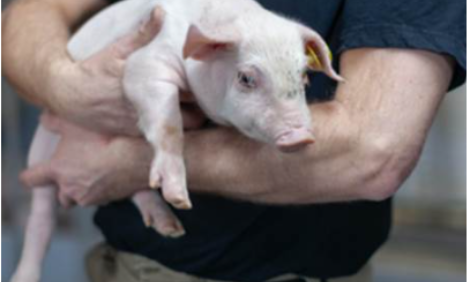



Effect of Social Group Size on Aggressive Behaviour of Grower-finisher Pigs
By Thusith S. Samarakone and Harold W. Gonyou, Prairie Swine Centre Inc. Published by Bacon Bits, Alberta Agriculture, Food and Rural Development - The effect of large group size on the social behaviour of pigs is poorly understood. A study was conducted to assess the social aggression of grower-finisher pigs in large groups. Pigs with large social group experience displayed a significant reduction in aggressive behaviour compared to those living in small social groups.Introduction
Most studies into social behaviour in pigs have been limited to relatively small group sizes (<40 pigs/group) compared to the group sizes that are now used in some commercial practices.
The social strategy adopted by pigs in large social groups is not well understood, but it could be expected that the pigs in larger groups would adopt different social strategies than those exhibited by pigs in small social groups. Any changes in the social behaviour of pigs in larger groups could directly affect the overall welfare and productivity of the animals. The objective of the present study was to determine the effect of large social groups on aggressive behaviour of grower-finisher pigs.
Experimental Procedures
Eight blocks, each comprising four pens of 18 pigs (SG) and two pens of 108 pigs (LG) on fully slatted floors (0.76 m2/pig), were used in the experiment. Initial body weights averaged 32 ± 5 kg, with equal numbers of barrows and gilts in each pen. Pigs were fed from multi-space wet/dry feeders, with a pig-to-feeder space ratio of 9:1.
Three studies were conducted to evaluate the aggressive behaviours of pigs. Study1: Initial level of aggression was recorded for 2 hours, starting 0, 24 hr and 48 hr following group formation. Study 2: On weeks 1, 6 and 12 on test, a selected pair of pigs from a pen (SG or LG) was transferred to another pen (SG or LG) to assess the effect of social experience (SG vs. LG) on aggressive behaviour upon mixing into an established social group (SG vs. LG). Aggressive behaviours were recorded for 2 hr in a total of 4 different combinations (88 pigs/combination). Study 3: After 8 weeks on test, a total of 200 pigs were re-grouped for 2 hr in a separate small pen in groups of 4 to assess the effect of prior social experience (SG vs. LG) on aggression with pigs from their own pen or unfamiliar pigs from SG and LG.
Results and Discussion
Study 1: There was no difference, up to 48 hr following grouping, in the percentage of time observed fighting between the 2 group sizes.
Study 2: When pigs with large social group experience were mixed into an established large social group (LL), a significant reduction in time spent in aggressive behaviours was observed between the intruder and the resident pigs (P<0.05) than when pigs with LG experience were introduced to SG (LS), or SG experience were introduced to LG (SL) or SG (SS) (Figure 1).
Study 3: Upon re-grouping at week eight, pigs derived from two SG showed an increased level of aggression towards unfamiliar pigs compared to those that were derived from two LG. When pigs derived from SG and LG were combined, an intermediate level of aggression was observed (Figure 2). This result indicates a reduction in aggressive behaviour by pigs living in large social groups.

Figure 2. Mean duration of fighting observed in 5 different pig combinations tested (P<0.05). (Test combinations: 4 pigs from the same SG (S), same LG (L), 2 pigs each from 2 different SG (SS), 2 different LG (LL) and 2 pigs from a SG and 2 pigs from a LG (SL)).

Conclusion
Large group size did not cause higher aggression following group formation. Pigs formed into large social groups appear to modify their social organization by adopting a non-aggressive, tolerant social strategy, which is indicated by the reduction in aggressive behaviours. This information may provide potential benefits for the welfare of pigs under commercial production situations.
Acknowledgements
Strategic program funding provided by Sask Pork, Alberta Pork, Manitoba Pork Council and Saskatchewan Agriculture and Food Development Fund. Additional funding for this project was provided by NSERC.
Source: Bacon Bits - Alberta Agriculture, Food and Rural Development - July 2004








